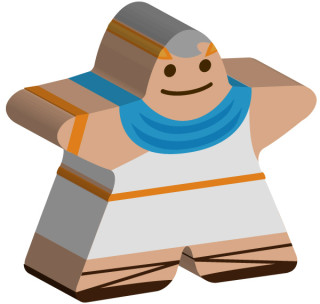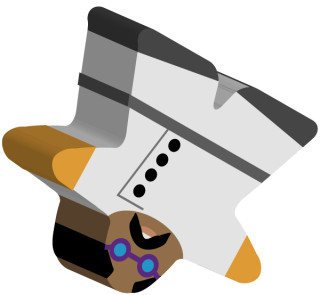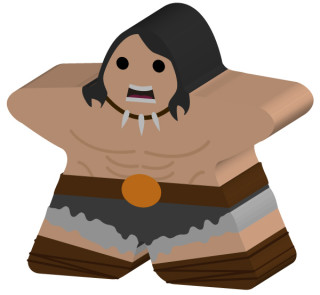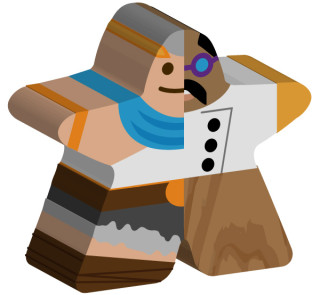There has long been a deep chasm in the realm of board games. In recent years, the chasm has narrowed and even a few bridges have built, but there are still some gamers who will not leave their side of their rift for the land on the other side. In board games, the grass is always greener and much more fun on your side. I don’t have a name for the rift, but there is a name for the two sides, Euro games and Ameritrash. In this post I want to move beyond that simple divisive line by creating even more divisions. Don’t worry, I’m not trying to start a new board game cold war, this all has a point, but you’re going to have to trust for me now.
Your parents probably told you there are two types of designers in the world, European designers who like systems and hate randomness and player interaction, and Americans who really just want to create a game that has you throwing dice at your friends, but have to settle for letting you roll them. Like in most things, your parents were lying. Today, I’m going to expand your world and talk about the three and a half tribes of board game designers, which I have adapted / stolen from Scott McCloud’s book about a different medium, Making Comics. McCloud describes four tribes in his book, groups of individuals that have no official affiliation but share a distinct set of values that underpin the way they approach their craft / art / work. McCloud’s tribes work very well to describe comic creators, filmmakers and writers, but I’ve had a little difficulty getting them to translate exactly over to the unique medium of the the tabletop (hence the half).
As a designer, I find these tribes interesting to think about (and I hope you do, too), because they make me evaluate my values about what makes a good game, and inform how I approach game design. I’m going to describe each tribe below, and pick out a designer that I believe belongs in that tribe. I’d love to hear which tribe you belong to and, of course, if you think I’ve unfairly pegged any of the designers into the wrong tribe.
Old World
 First of all, we have the Classicists. The Classicists focus on craft above all else, striving to create games that meet the Platonic ideal of good design. A classicist will be proud of creating a balanced system that allows player to exercise their strategy and wit. Most European game designers belong to the classicist tribe, with Uwe Rosenberg being a great example, as he hones and revisits mechanisms that he has explored in previous games. His games involve deep thought, difficult decisions and the feeling that one is control of their own destiny, but not a lot of luck, crazy powers or head-to-head player conflict.
First of all, we have the Classicists. The Classicists focus on craft above all else, striving to create games that meet the Platonic ideal of good design. A classicist will be proud of creating a balanced system that allows player to exercise their strategy and wit. Most European game designers belong to the classicist tribe, with Uwe Rosenberg being a great example, as he hones and revisits mechanisms that he has explored in previous games. His games involve deep thought, difficult decisions and the feeling that one is control of their own destiny, but not a lot of luck, crazy powers or head-to-head player conflict.
Designers of other tribes, particularly contemporary designers, will often take the classicist pursuit of craft and meld it with their other values. On the opposite end of the Euro-Ameritrash spectrum, I’d suggest Eric Lang (who by affiliation better belongs to our 3rd tribe) is also a student of the classicist school. Lang has crafted many great games, with a greater diversity that Rosenberg, but the same excellence of craft.
Other World
 Next are the formalists. They are defined by their fascination with form, they seek to push the medium and experiment to create new forms of expression. They could also (excuse my Australian) be described as post-modern wankers. It’s a little bit harder to cordon off tabletop designers into this tribe, as most designers have at least one foot in it. Board games are such a relatively new medium that most designers must innovate and experiment to express their ideas. I could pick out Antoine Bauza as a formalist poster boy, using Hanabi as a prime example. It’s a game that plays with the medium itself, turning a simple trope on its head and making games seem new again, but not all his games are as innovative (although one could argue for both 7 Wonders and Terror in Meeple City).
Next are the formalists. They are defined by their fascination with form, they seek to push the medium and experiment to create new forms of expression. They could also (excuse my Australian) be described as post-modern wankers. It’s a little bit harder to cordon off tabletop designers into this tribe, as most designers have at least one foot in it. Board games are such a relatively new medium that most designers must innovate and experiment to express their ideas. I could pick out Antoine Bauza as a formalist poster boy, using Hanabi as a prime example. It’s a game that plays with the medium itself, turning a simple trope on its head and making games seem new again, but not all his games are as innovative (although one could argue for both 7 Wonders and Terror in Meeple City).
Richard Garfield is probably a better contender for the prize. He created a whole new genre with Magic and today his designs still stand out as unique. Netrunner, now on its second life, plays with the idea of cards as physical objects and creates a truly asymmetrical play experience. King of Tokyo, while it has Yahtzee at its heart, can be read as a riff on the idea of king making and political games.
As a quick aside, Garfield also has some tribes of gamers that he often discusses, although these relate to play styles rather than values (there is some relation between the two). The Ludology podcast recently did an interview with the good doctor, where he talks about these types (among lots of other things). He also reveals the genesis of King of Tokyo, as well as his general game design process, which I think help confirm him for the crown of formalist king.
New World

This tribe and the next tribe are a bit trickier to adapt from McCloud’s four, as they focus more on content than mechanics, and mechanics are really where games shine, so bear with me. This tribe, the animists, are described by McCloud as putting content first. In other art forms, animists let the story shine through above else, eschewing the baroque devices of the classicists and the intruding innovation of the formalists. I’m going to translate this into focussing on conveying the imagined world of the game, and evoking an emotional (as opposed to intellectual) response. Yes, the animists are theme-first Ameritrashers.
In this tribe, it’s the fun that matters, and both strategy and innovation go by the wayside. This tribe, while not the most respected, is the one that draws in the most players and the most dollars (at least for us non-Europeans). We can throw entire genres (party games) and mechanics (dexterity) into the animist tribe, and have plenty of room for all those games from our childhood that had us circling around a board over and over again, but we’d be selling the tribe short. So, instead of pointing to a particular designer as emblematic of the animist tribe, I’m going to point to a publisher, Fantasy Flight Games. Their recent releases may be far from innovative, in fact many of their latest games are reworkings of old ideas with a fresh new license on top, but they wonderfully evoke the theme they’re trying to express.
Real world
![]() And finally we have the iconoclasts, the half tribe. The iconoclasts are a rare and seldom seen tribe in tabletop design, a medium that is arguably mostly about escapism. The iconoclasts focus on creating a connection to real life, and value authenticity and honesty. There are few designers, and even fewer publishers, who seek to create games that accurately to convey modern life, but we could stretch things a little. Vlaada Chvátil, like his countrymen Milan Kundera and Franz Kafka, has a very unique approach to his craft, formalist in many ways, but with a desire to explore the contemporary human condition, rather than just wax (or roll) poetical. In Space Alert, you don’t play a captain taking control of a powerful spaceship against a valiant and cunning foe, you play one of a few frantic crew members trying to operate a decrepit ship against daunting but somewhat random odds. In Space Alert, you feel some of the stress and anxiety that you feel in real life. Despite the zaniness, it is really a simulation of being in a high stress environment, it feels closer to work than play at times. His games, while often sporting an overlay of science fiction or fantasy, dig down into the minutiae of these worlds to better tie them to our real lives.
And finally we have the iconoclasts, the half tribe. The iconoclasts are a rare and seldom seen tribe in tabletop design, a medium that is arguably mostly about escapism. The iconoclasts focus on creating a connection to real life, and value authenticity and honesty. There are few designers, and even fewer publishers, who seek to create games that accurately to convey modern life, but we could stretch things a little. Vlaada Chvátil, like his countrymen Milan Kundera and Franz Kafka, has a very unique approach to his craft, formalist in many ways, but with a desire to explore the contemporary human condition, rather than just wax (or roll) poetical. In Space Alert, you don’t play a captain taking control of a powerful spaceship against a valiant and cunning foe, you play one of a few frantic crew members trying to operate a decrepit ship against daunting but somewhat random odds. In Space Alert, you feel some of the stress and anxiety that you feel in real life. Despite the zaniness, it is really a simulation of being in a high stress environment, it feels closer to work than play at times. His games, while often sporting an overlay of science fiction or fantasy, dig down into the minutiae of these worlds to better tie them to our real lives.
We can also place other games with a high tendency towards simulation in the iconoclast tribe, including many war games. Unfortunately, my knowledge of war games is a bit lacking, so I’m just going to say Advanced Squad Leader, as I am vaguely aware that it is quite complicated and therefore probably fits the description.
Tribal Mixing
 Hopefully, I’ve given you a little bit of something to think about, but there’s not a lot you can act on yet. You may find yourself identifying as one of the tribes, but you probably already knew that, you just didn’t have my specific word for it. Next time, I’m going to discuss what happens when you start mixing the tribes together, taking some values from one tribe and mixing them with another. (Spolier: sometimes it goes horribly wrong!)
Hopefully, I’ve given you a little bit of something to think about, but there’s not a lot you can act on yet. You may find yourself identifying as one of the tribes, but you probably already knew that, you just didn’t have my specific word for it. Next time, I’m going to discuss what happens when you start mixing the tribes together, taking some values from one tribe and mixing them with another. (Spolier: sometimes it goes horribly wrong!)
P.S. thanks to Meeple Source for the illustration inspiration! If you want custom meeples for your Euro games or your Ameri-games with Euro bits, check them out!
7 thoughts on 3.5 tribes of board game designers
Comments are closed.
Good read. I’d suggest someone like Brenda Romero or Phil Eklund as an Iconoclast: people who design board games not purely for commercial value but for their own aesthetic ideals.
Do you think Vlaada’s off? I know it’s a bit of stretch. I’ve only vaguely heard of Phil Eklund’s work, it seems quite unique. It’s hard to frame iconoclast in board game terms and remain faithful to McCloud, the need for abstraction is so magnetic in board gaming it’s hard to stay authentic to life. I think we have to give the merit badges mostly on theme for iconoclast. Brenda Romero gets a badge and mention in part 2!
I don’t think Vlaada is completely off, just that Phil Eklund and Brenda Romero illustrate the point clearer 😉 Vlaada can be seen as an iconoclast because his designs don’t neatly fit into the major design schools, but are still generally accepted. He’s more of a mix than a true iconoclast, in my opinion.
Phil Eklund is an excellent example – with High Frontier as his “masterpiece”. He is perhaps also a candidate for the Real World camp …
Lovely stuff but I think the Real World group includes political games like Monopoly in its original form, and Train, and the new and wonderful Freedom. So it’s not a half at all.